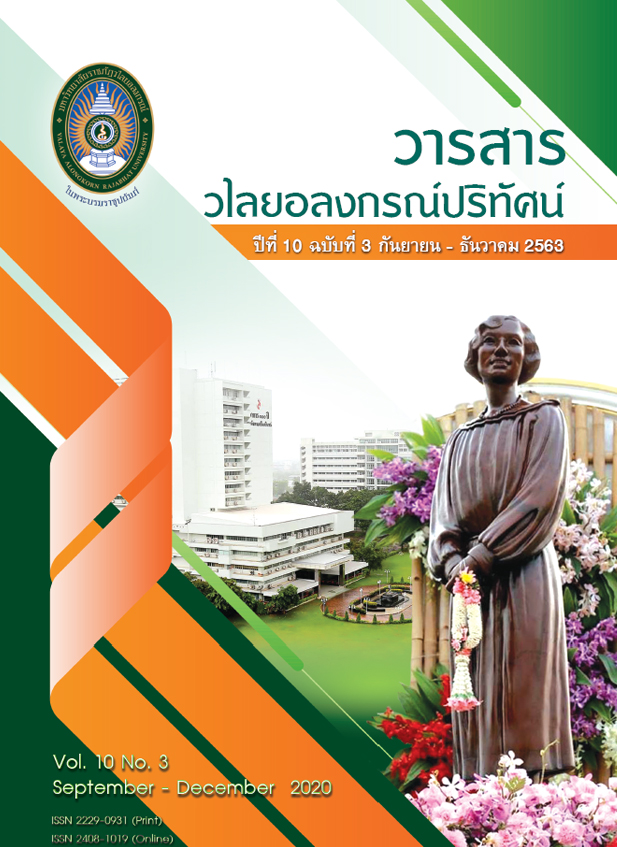การเปรียบเทียบพญานาคกับมังกรในมุมมองของศาสนาและความเชื่อ
คำสำคัญ:
การเปรียบเทียบ, พญานาค, มังกร, ศาสนา, ความเชื่อบทคัดย่อ
ความเชื่อเป็นลักษณะความคิดอย่างหนึ่งของมนุษย์อันเป็นที่ยึดเหนี่ยวทางจิตใจ ซึ่งสามารถกล่าวได้ว่า “เพราะความเชื่อจึงก่อให้เกิดการบูชา” ด้วยความกลัวเรื่องงูจึงเป็นปัจจัยสำคัญที่ก่อให้เกิดความเชื่อและการนับถือบูชางูเพื่อเป็นขวัญกำลังใจ ปัจจุบันคนจำนวนมากมีความเชื่อเกี่ยวกับเรื่องงูจากเรื่องราวของพญานาคกับมังกรที่ปรากฏอยู่ในคัมภีร์และเรื่องราวทางพระพุทธศาสนา จากการศึกษาเปรียบเทียบพญานาคกับมังกรในมุมมองของศาสนาพบว่ามีความคล้ายคลึงกัน คือ สัตว์ทั้งคู่มีความประสงค์ที่จะหลุดพ้นจากการเกิดเป็นสัตว์ ประกอบกับได้ฟังธรรมเทศนาจึงบังเกิดดวงตาแห่งธรรมศรัทธาเลื่อมใสในพระพุทธศาสนา และต่อมาได้หลุดพ้นจากการเป็นสัตว์และกลายเป็นเทพ ส่วนในมุมมองของความเชื่อพบว่ามีความคล้ายและความต่างกัน คือ มีความเชื่อเรื่องการบูชาสัตว์ทั้งคู่ที่เป็นตัวแทนแห่งความโชคดีและความอุดมสมบูรณ์ แต่สัตว์ทั้งคู่มีอิทธิฤทธิ์ แตกต่างกันพญานาคสามารถพ่นดวงไฟ ส่วนมังกรสามารถเหาะเหินเดินอากาศได้ และสัตว์ทั้งคู่ ไม่สามารถพิสูจน์ทราบได้ว่ามีจริงหรือไม่ เพราะมักจะปรากฏอยู่ในนิทานปรัมปราและเรื่องราวต่าง ๆ
เอกสารอ้างอิง
จิตรา ก่อนันทเกียรติ. (2545). พระพุทธ พระโพธิสัตว์ สิ่งศักดิ์สิทธิ์ของจีน. กรุงเทพฯ: จิตรา.
จีระพงษ์ โคตรชมพู. (2538). ประวัติของพญานาค. [ออนไลน์], เข้าถึงได้จาก: https://sites.google.com/site/yjuryueuymju/trakul-khxng-nakh (2539, 3 มกราคม).
ประทุม ชุ่มเพ็งพันธ์. (2544). รัชกาลที่ 3 กับการสร้างวัดสำคัญ กำเนิดตุ๊กตาศิลาจีน. กรุงเทพฯ: ชมรมเด็ก.
ราชบัณฑิตยสถาน. (2542). พจนานุกรมฉบับราชบัณฑิตยสถาน. กรุงเทพฯ: นานมิบุ๊คส์ พับลิเคชั่นส์.
วศิณี บูรณวุฒิกุล. (2553). ปัจจัยที่มีผลต่อความเชื่อเรื่องมังกรของคนไทยเชื้อสายจีน. กรุงเทพฯ: บัณฑิตวิทยาลัย มหาวิทยาลัยรามคำแหง
วิเชียร นามการ. (2554). การศึกษาอิทธิพลความเชื่อเรื่องพญานาคที่มีผลต่อสังคมไทยปัจจุบัน. วิทยานิพนธ์ปริญญาพุทธศาสตรมหาบัณฑิต สาขาวิชาพระพุทธศาสนา มหาวิทยาลัยมหาจุฬาลงกรณราชวิทยาลัย.
เศรษฐพงษ์ จงสงวน. (2562). ภาพลักษณะของมังกร. [ออนไลน์], เข้าถึงได้จาก: http://kuaibao.qq.com/s/20190124A1EKTL00?refer=spider (2562, 7 มกราคม).
สมชาติ มณีโชติ. (2528). ความเชื่อเรื่องพญานาคในพระพุทธศาสนา. กรุงเทพฯ: แสงศิลป์.
สมบัติ พลายน้อย. (2510). ความสัมพันธ์ระหว่างงูกับมนุษย์. กรุงเทพฯ: แสงศิลป์.
สุจิตต์ วงษ์เทศ. (2546). นาคในประวัติศาสตร์อุษาเนย์. กรุงเทพฯ: มติชน.
อุดม รุ่งเรืองศรี. (2523). สภาพของวรรณกรรมไทยปัจจุบัน. กรุงเทพฯ: ศิลปบรรณาคาร.
Wang, L. (2555). การศึกษาเปรียบเทียบตำนานการกำเนิดและประเพณีความเชื่อที่เกี่ยวข้องกับพญานาคของไทยและมังกรของจีน. วิทยานิพนธ์ศิลปศาสตรมหาบัณฑิต สาขาวิชาการสื่อสารภาษาไทย เป็นภาษาที่สอง มหาวิทยาลัยหัวเฉียวเฉลิมพระเกียรติ.
ดาวน์โหลด
เผยแพร่แล้ว
รูปแบบการอ้างอิง
ฉบับ
ประเภทบทความ
สัญญาอนุญาต
ข้อความที่ปรากฏในบทความแต่ละเรื่องในวารสารวไลยอลงกรณ์ปริทัศน์ เป็นความคิดเห็นของผู้นิพนธ์แต่ละท่าน มิใช่เป็นทัศนะและมิใช่ความรับผิดชอบของกองบรรณาธิการจัดทำวารสาร และ
มหาวิทยาลัยราชภัฏวไลยอลงกรณ์ ในพระบรมราชูปถัมภ์


